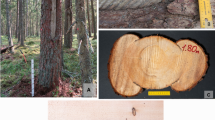Summary
The fungi most frequently inhabiting thinning slash ofPinus radiata were isolated and recorded in a typical South Australian plantation. These includedStereum sanguinolentum, Peniophora sp. (undescribed, close toPeniophora pini),Schizophyllum commune, Coriolus sanguineus, Peniophora gigantea, Trichoderma viride, Penicillium sp.,Aureobasidium pullulans, Macrophoma sabinea andLeptographium spp. Antagonistic potentialities in vitro suggested that the less destructive of these deserve to be studied in the biological control ofS. sanguinolentum. Their occurrence might be manipulated by proper slash disposal sinceS. commune andPeniophora sp. were favored by moderate exposure andP. filamentosa andP. gigantea by protection from exposure. Very exposed slash was not occupied by any fungi.
Similar content being viewed by others
References
Baigent, N. L. &Ogawa, J. M. 1960. Activity of the antibiotic produced byPullularia pullulans (Asb.). Phytopathology50: 82.
Cunningham, G. H. 1963. Thelephoraceae of Australia and New Zealand. New Zealand Dept. Sci. Ind. Res. Bull.145: 1–359.
Davidson, A. G. &Etheridge, D. E. 1963. Infection of balsam fir,Abies balsamea (L.)Mill. byStereum sanguinolentum (Alb. &Schw. exFr.)Fr. Canad. J. Bot.41: 759–765.
Etheridge, D. E. 1962. Conditions influencing the entry ofStereum sanguinolentum Alb. &Schw. exFries in balsam fir. Can. Dept. For., For. Entom. Pathol. Branch Bi-mo Rept.118: 2–3.
Etheridge, D. E. &Morin, L. A. 1963. Colonization by decay fungi and dead stems of balsam fir following artificial injury. Canad. J. Bot.41: 1532–4.
Hunt, J. &Krueger, K. W. 1962. Decay associated with thinning wounds in young growth of Western hemlock and Douglas fir. J. Forestry60: 336–340.
Nobles, Mildred K. 1948. Studies in forest pathology VI. Identification of cultures of wood-rotting fungi. Canad. J. Res. (C)26: 281–431
Rawlings, G. B. 1960. Fungi associated withPinus radiata. In:Scott, C. W.:Pinus radiata. FAO Forest and Forest Product Studies, pp. 250–320.
Rishbeth, J. 1959. Stump protection againstFomes annosus. II. Treatment with substances other than creosote. Ann appl. Biol.47: 529–541.
——. 1963. Stump protection againstFomes annosus. III. Inoculation withPeniophora gigantea. Ann. appl. Biol.52: 63–77.
Scott, C. W. 1960.Pinus radiata. FAO. Forest and For. Prod. Stud.14: 1–328.
Stoddart, W. T. 1960. Pruning wounds — Norway spruce. Quart. J. Forestry54: 375–376.
Walters, N. E. M. 1962. Fungi in the herbarium of wood preservation section, division of forest products. CSIRO Div. For. Prod. Prog. Rept.2: 40 p.
Author information
Authors and Affiliations
Rights and permissions
About this article
Cite this article
Vaartaja, O. Wood inhabiting fungi in a pine plantation in Australia. Mycopathologia et Mycologia Applicata 34, 81–89 (1968). https://doi.org/10.1007/BF02050848
Issue Date:
DOI: https://doi.org/10.1007/BF02050848




